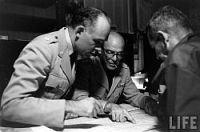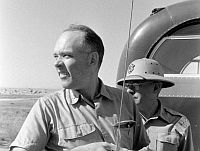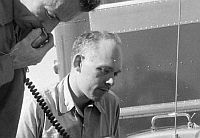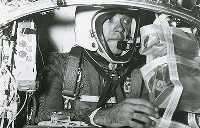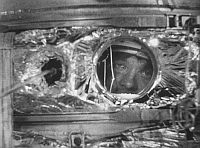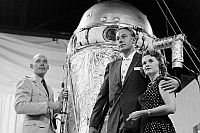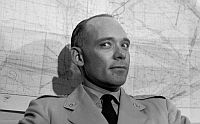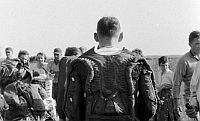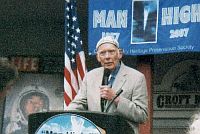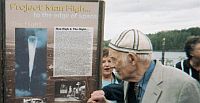One of the pioneers of early space exploration, Dr. David G. Simons, passed away on April 5, 2010. Dr. Simons, a former United States Air Force Flight Surgeon, was chief scientist for Project Manhigh in the 1950s and piloted the program's second flight to a record-setting altitude of 102,400 feet above sea level.
Early years
A native of Lancaster, Pennsylvania, USA, Simons came from a family of physicians. His father, Sam, and Uncles Ike and John, all of them doctors, ran the Simons Medical Clinic on Duke Street in Lancaster. His brother Will, a dentist, also practiced at the clinic. Simons completed his undergraduate work at the Franklin and Marshall College in Lancaster, then entered Jefferson Medical College in Philadelphia and performed a 15-month rotating internship at Lancaster General Hospital. His father had also attended the Jefferson Medical College, and it was generally taken for granted that David G. Simons, M. D., would join the family clinic.
Simons received support for this education through the Army Specialist Training Program and had a two-year service obligation when he finished his internship. As a youth, he spent a great deal of time with Hiram Walker, a part-time student at Franklin and Marshall College who worked as a medical technician at his family's medical clinic. Walker was a licensed ham radio operator who instilled a fascination for radio and electronics in the young Simons.
Despite his heavy course load at Jefferson Medical College and the demands of his internship, he found time to learn Morse code with an eye towards earning a radio operators' license. At the time, though, use of amateur radios was banned due to the Second World War. Later, Simons secured permission to set up a radio station at Lancaster Hospital. He also studied astronomy in his off-duty hours.
The air force years
When he entered the Army Air Force as a First Lieutenant on August 17, 1947, Simons asked for an assignment that combined his medical training with his interest in electronics. This led to his being assigned to the Aero Medical Laboratory at Wright Field and his work with Dr. James P. Henry, who headed the Laboratory Acceleration Section. Promoted to Captain in 1948, Simons designed and built electronic devices for the laboratory centrifuge. He soon discovered he preferred a career in scientific research rather than medical practice, so he decided to stay in the Air Force.
One day, Dr. Henry asked Simons if he thought man would ever go to the moon. In college, Simons had read articles about space travel and answered he believed it certainly was possible. Henry continued, "Well, what would you think of having an opportunity to help us put a monkey in a captured V-2 rocket that would be exposed to about two minutes of weightlessness and measure the physiological response to weightlessness?" After Simons' enthusiastic and unqualified yes, Henry appointed him Project Officer for the first attempt to launch a primate into space. Henry and Simons selected a nine-pound American-born Rhesus monkey for their passenger. Someone in the Wright Field Parachute Branch nicknamed the monkey "Albert," and the name stuck.
The Albert I capsule was oddly shaped and the monkey was in a very awkward position, with his chin against his chest. The launch was set for June 11, 1948. Data recorded during the flight indicated Albert probably suffocated before launch due to the cramped position. The parachute failed, so in any event, Albert would not have survived the flight. Simons and Henry redesigned the capsule and tried again on June 14, 1949. Again, the parachute failed, but data indicated Albert II survived until impact.
After the second Albert flight, Captain Simons attended the Air Force Advanced Course in Aviation Medicine at Randolph Air Force Base in Texas and became a certified flight surgeon in 1950. Following a tour of duty in Japan during the Korean War as Base Surgeon at Yakota Air Force Base, he briefly returned to the Aero Medical Laboratory before being assigned to the Aeromedical Field Laboratory (AMFL) at Holloman Air Force Base in Alamogordo, New Mexico.
Simons took charge of the cosmic radiation research program at the AMFL. He used polyethylene balloons to carry small animals and biological specimens to altitudes of 100,000 feet or more to expose them to cosmic radiation. By 1955, after dozens of flights, Lieutenant Colonel John Paul Stapp (commanding officer of the AMFL) asked Simons if he was ready to try a high altitude flight with a human test subject. This became Project Manhigh.
Project MANHIGH
Officially, the justification for Manhigh was the design of a prototype space capsule, but Simons always kept his focus on the biological effects of cosmic radiation. He worked closely with Winzen Research, Inc, the project contractor, to design the Manhigh capsule. For its day, the capsule was an incredible piece of engineering - a sealed cabin that could sustain a pilot for 24 hours in a space-equivalent environment.
After a test flight by Air Force Captain Joseph W. Kittinger, Simons piloted the second flight himself. This was a 24-hour flight with a 3-million cubic foot balloon to 100,000 feet. Throughout his flight, Simons had a full agenda of scientific observations to perform. He took off early in the morning on August 19, 1957, from an open pit iron mine in Crosby, Minnesota. He reached a peak altitude of 102,400 feet above sea level. Simons spent the day floating above 100,000 feet. The next morning, a line of thunderstorms that moved in during the night forced him to delay his landing. Simons remained aloft until 5:32 PM CDT. His flight had lasted more than 32 hours, by which time electrical power in the capsule had reached critical levels and carbon dioxide was building up in the cabin. Manhigh II was hailed as a brilliant accomplishment and Simons appeared on the cover of Life magazine.
The final flight of the program, Manhigh III, took place on October 8, 1958. Lieutenant Clifton C. McClure reached 99,700 feet. After Manhigh III, Simons was promoted to Lieutenant Colonel and transferred to the Air Force School of Aerospace Medicine, where he headed the Bioastronautics Branch. During Project Mercury, Simons served as a medical monitor and supported the first American manned space flights.
His life outside the air force
Simons retired from the Air Force in 1965 as a Lieutenant Colonel and turned his attention to another line of research - the diagnosis and treatment of myofascial pain. He co-authored The Trigger Point Manual, the first definitive textbook on the diagnosis and management of myofascial pain. Dr. Simons went on to author more than 200 publications about trigger points and chronic pain management and became an internationally recognized authority on the subject.
He was inducted into the International Space Hall of Fame in Alamogordo, New Mexico, in 1987, which was when this author had the honor of meeting him. He was not one to rest on his laurels and was more interested in being recognized for his current research in the treatment of chronic pain than he was for his past contributions to space exploration. Twenty years later, our paths crossed again at the 50th anniversary celebration of Manhigh II, which was held in Crosby. At the ceremony that was held on the day of the anniversary, his keynote address was titled "The Messenger Is Not the Message". Dr. Simons sought to downplay his own role in Manhigh and instead wanted to emphasize the science and knowledge that was gained. However, if not for his insight, personal courage and commitment to research, the scientific results would never have been achieved.
Dr. Simons never fully retired. At the time of his death, he was living in Covington, Georgia, USA, and was a Professor at Emory University and an Adjunct Professor at the University of Saint Augustine. He was also fully engaged in the latest revision of The Trigger Point Manual.
About the author
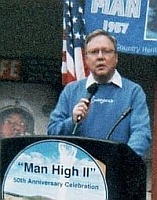
Gregory P. Kennedy is an internationally known expert in aerospace history. He has authored, co-authored, or edited eight books on space history including Touching Space: The Story of Project Manhigh, which was released by Schiffer Publishing Company of Atglen, Pennsylvania (www.schifferbooks.com).
He has also published numerous articles on the Manhigh project and recently appeared on a PBS documentary entitled "Space Men".
With nearly 40 years' experience in aviation and space museums, Mr. Kennedy has worked at the Smithsonian Institution; the Space Center; American Airlines C. R. Smith Museum; and No. 1 British Flying Training School Museum. While at the Smithsonian, he was Associate Curator for the National Air and Space Museum's collection of manned space flight artifacts.
It was during his tenure at the Smithsonian that he became fascinated with Project Manhigh and the contributions of high-altitude ballooning to space exploration. At the Space Center (currently known as the New Mexico Museum of Space History) in Alamogordo, New Mexico, Mr. Kennedy met many Project Manhigh personnel.

